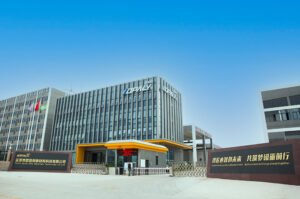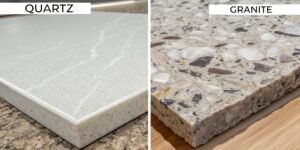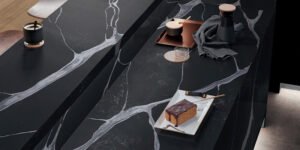In bulk quartz slab sourcing, unmanaged waste drives up costs and delays, cutting into both supplier margins and client profitability.
Minimize waste by optimizing cutting patterns, ensuring strict quality control, improving packaging, aligning supply with demand, and recycling offcuts effectively.

In this guide, I’ll walk through five essential steps to reduce waste across the quartz stone supply chain, explaining industry best practices and how a supplier like Opaly meets or exceeds these benchmarks.
How can cutting patterns improve material utilization?
Poor cutting plans result in large offcuts and unnecessary slab purchases.
Use digital slab mapping and pre-approved cutting layouts to maximize usable yield from each slab.
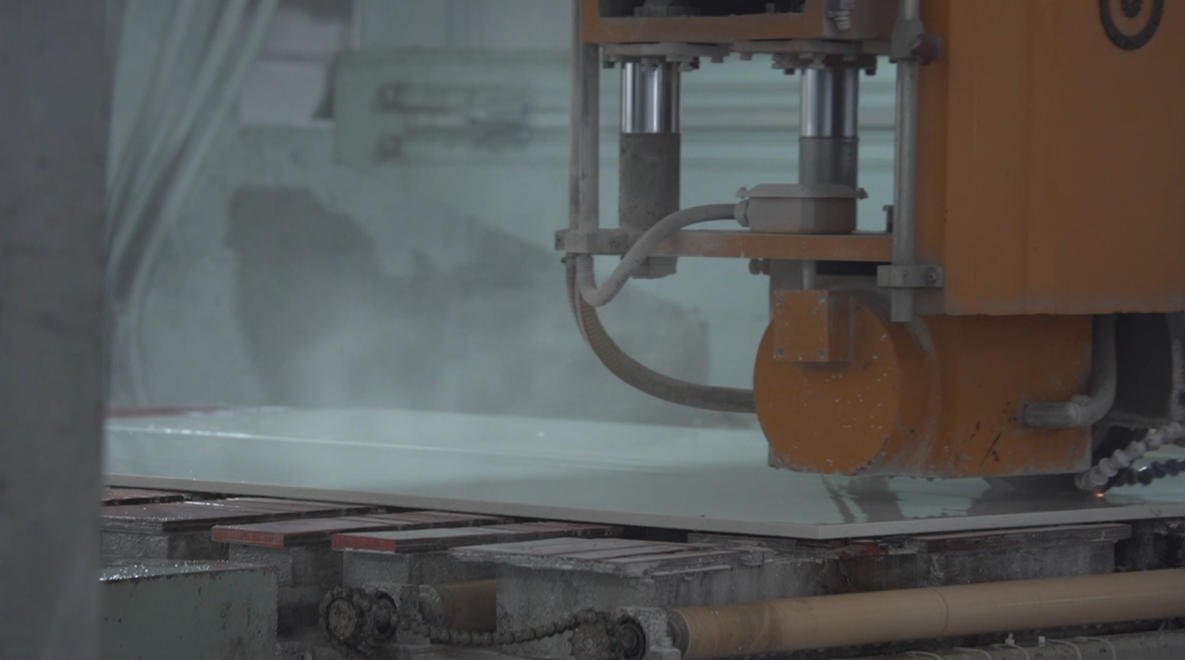
Maximizing slab yield is crucial in bulk procurement because even a 5% improvement in utilization can translate to thousands of dollars saved on large projects. The industry standard is to use CAD-based nesting software to arrange pieces for minimal waste, combined with standardized slab sizes to fit common project dimensions. Skipping this step often leads to oversized orders, excess offcuts, and increased storage costs. Success is measured by yield percentage—calculated as usable surface area divided by total slab area. Opaly provides digital slab layout previews before production and ensures every batch follows optimized cutting plans, reducing waste at the very first stage.
| Standard Practice | Meaning | Example Value |
|---|---|---|
| Digital slab mapping | CAD planning for optimal cutting | 95%+ yield |
| Standard slab sizing | Common dimensions to fit demand | 3200×1600 mm |
| Pre-approval of layouts | Client checks plans before cutting | 100% approved before cut |
How does quality control reduce defective slabs?
Uncaught defects lead to rejected shipments and costly replacements.
Implement multi-stage inspections from raw material intake to final polishing to catch defects early.
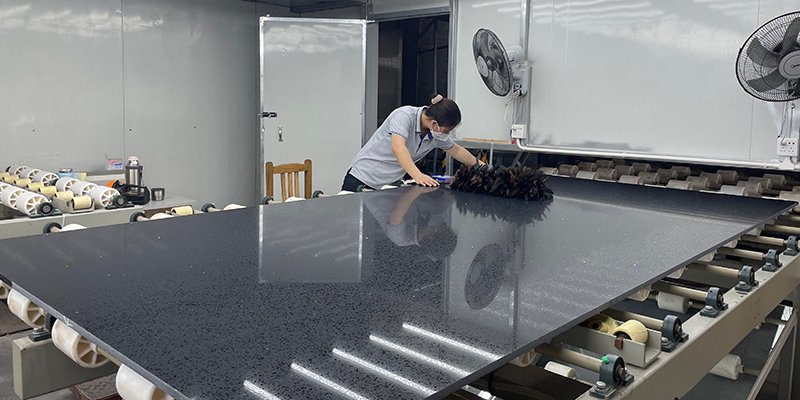
Quality control is vital because defects like color inconsistency, voids, or resin imbalance can make slabs unsellable. Best practice involves testing raw quartz for purity, monitoring resin-to-stone ratios, and inspecting slabs after curing and polishing. Industry leaders test density (ASTM C97), water absorption (EN 14617-1), and flexural strength. Skipping these steps increases the risk of shipping unusable slabs that must be scrapped or returned. Success is measured by defect rate—typically less than 2% for top suppliers. Opaly uses batch-based QC with full traceability, ensuring only slabs meeting both international standards and client specifications are shipped.
| Standard Practice | Meaning | Example Value |
|---|---|---|
| Density testing | Ensures stone compactness | ≥ 2.3 g/cm³ |
| Water absorption check | Prevents moisture-related damage | ≤ 0.02% |
| Color consistency audit | Visual match across batch | ΔE ≤ 1.0 |
How can packaging and transport prevent breakage waste?
Improper handling during shipping causes expensive breakage losses.
Use reinforced wooden crates, edge protection, and anti-vibration measures for container transport.

In international supply chains, slabs often travel thousands of kilometers, making them vulnerable to chips, cracks, and breakage. Best practice includes reinforced ISPM-15 wooden crates, corner protectors, moisture barriers, and foam padding, combined with careful container loading to minimize shifting. Skipping this step can result in damage rates of 5% or more. Success is measured by damage claims per shipment—industry leaders keep this below 1%. Opaly’s packaging uses double-thickness edge protectors and anti-vibration bracing, and all loading teams are trained to handle quartz slabs in compliance with export safety standards.
| Standard Practice | Meaning | Example Value |
|---|---|---|
| Reinforced wooden crates | Strong frame to resist impact | ISPM-15 certified |
| Edge protection | Guards corners and sides | 10 mm foam |
| Anti-vibration bracing | Prevents slab movement in transit | Max 2 mm shift |
How does inventory planning reduce overstock waste?
Overproduction or overstocking ties up capital and risks slab damage.
Use demand forecasting tools and seasonal sales data to align production with market needs.
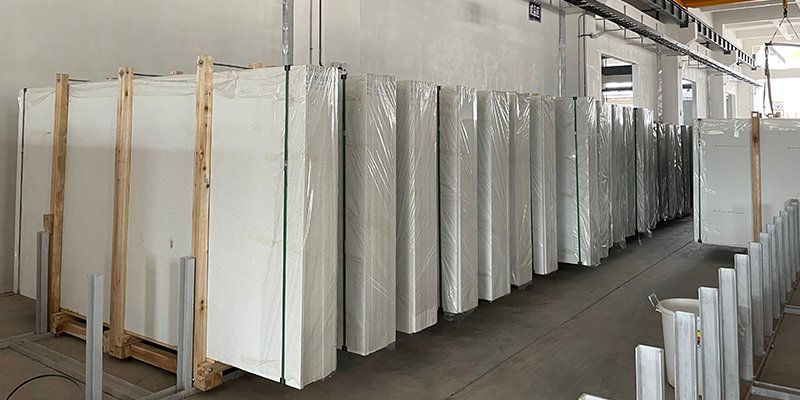
Maintaining the right stock levels is essential in bulk procurement because unused slabs can be damaged in storage or lose market appeal if designs fall out of trend. Best practice includes using ERP systems to track sales data, forecast demand, and adjust production schedules accordingly. Skipping this process often results in overstock, which increases storage costs and scrap risk. Success is measured by inventory turnover ratio, with efficient suppliers maintaining 6–8 turns per year. Opaly integrates sales data into production planning, ensuring slab production matches actual market demand.
| Standard Practice | Meaning | Example Value |
|---|---|---|
| Demand forecasting | Predicting sales trends | 90% accuracy |
| ERP inventory tracking | Real-time stock monitoring | Instant data |
| Inventory turnover target | Efficient stock movement | 6–8 turns/yr |
How can recycling programs cut total waste?
Disposing of offcuts adds cost and environmental impact.
Reprocess quartz waste into smaller products or use as raw material in new engineered stone.

Recycling is critical because even with perfect cutting plans, some offcuts are unavoidable. Industry leaders collect offcuts and grinding dust, crushing them into aggregate for terrazzo, pavers, or reintroducing them into the quartz production process. This reduces landfill use and supports sustainability goals. Skipping recycling increases disposal costs and environmental footprint. Success is measured by recycling rate—top performers achieve over 80% reuse of waste material. Opaly runs a closed-loop recycling system, where scrap is returned to the mixing process or fabricated into smaller custom pieces.
| Standard Practice | Meaning | Example Value |
|---|---|---|
| Offcut repurposing | Turning waste into sellable products | Backsplashes |
| Dust recovery | Using dust in new stone mix | 20% content |
| Recycling rate target | Proportion of waste reused | ≥ 80% |
Conclusion
Following these steps minimizes waste, lowers costs, and supports sustainability—Opaly applies all these practices to deliver maximum value with minimal loss.



